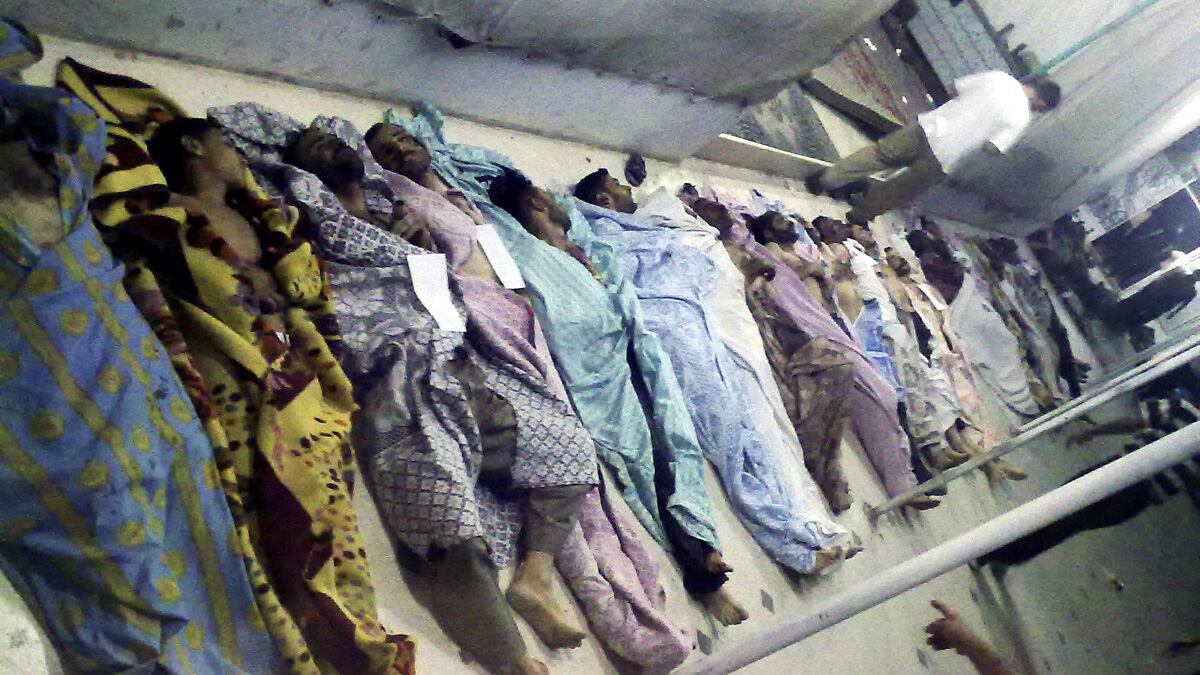The bodies around Damascus continue to pile up. On Sunday two prominent Syrian opposition groups ramped up the number of dead in the Damascus suburb of Daraya to more than 200 this week, following days of what appear to have been vicious attacks by regime forces. And the dead continue to turn up, the groups said, with many bearing the marks of execution. “There are still bodies being discovered,” says Sipan Hassan of the Syrian Observatory for Human Rights.
Much about the number and nature of the deaths has been difficult to verify. But rumors of the fearsome brutality with which victims were killed have already stretched far and wide among those pushing to overthrow Syrian President Bashar al-Assad. Sitting in a café Sunday night in the Turkish border city of Antakya, a hub for opposition activity, one rebel coordinator made a macabre chopping motion with his hand when the subject of Daraya was broached. A young associate then pulled up a grisly photo on his mobile phone that showed a man with his face cleaved between the nose and chin.
Whatever the facts on the ground in Daraya may be, word of the killings has already put a sense of fear into even seasoned members of the Syrian opposition.
“What was discovered in Daraya is horrible,” says a Damascus activist who goes by the name Alexia Jade. “Assad forces stormed through and killed anyone they came across. Their blood lust is uncontrollable.”
The Observatory for Human Rights now estimates that 320 people died in Daraya over the course of five days. Another leading opposition group, the Local Coordinating Committees, has put the number at more than 200 and counting. “There are still many bodies [that] couldn’t be reached yet,” it said in a statement Sunday.

The deaths appear to have resulted from both regime shelling and targeted killings. Daraya had been known to support the opposition, rebels and activists said, and members of the rebel Free Syrian Army fought to defend Daraya before regime forces beat them back. Most of the victims were men, the groups said, but women and children had also been found among the dead.
To date, the worst documented mass killing of the Syrian conflict is the one that took place in Houla in May. There, regime forces killed 108 people, including 32 children, according to a United Nations report. The Daraya killings, if confirmed, would surpass Houla in scale.
For residents in and around Damascus, the most frightening aspect of Daraya is that there seems to be little stopping the regime from inflicting the same kind of carnage on them. “The regime simply can,” says Jade. “They want to get the revolution over as soon as possible, and they don’t care how.”
Fear of the violence throughout Syria, meanwhile, seems to be on the rise as refugees surge across the borders in numbers that have raised alarm in neighboring countries. In Turkey, which hosts more Syrian refugees than any nation, the border with Syria was closed to Syrian refugees on Sunday night, leaving those seeking to cross waiting on the other side.
Suphian Altan, a spokesman for the Turkish foreign ministry, told the Daily Beast that the border would reopen in a matter of days as new camps are constructed to accommodate the rising numbers. Turkey has long painted 100,000 as its capacity for refugees. According to the Turkish government, the number has now topped 80,000. Altan said six camps were under construction, which would add an additional capacity of 60,000 people. "We are going to continue to accept the refugees," he said. "We will never turn them away in a humanitarian crisis."
It was Damascus that saw the most sensational of the rebel blows against Assad in a chain of attacks, last month, notably when a rebel bomb killed four members of his inner circle. The bombing, along with surprise outbreaks of fighting in Damascus and Aleppo, the country’s largest city and commercial center, seemed to shake the regime to its core. As defections mounted and a sustained rebel offensive took hold in Aleppo over subsequent weeks, there was a sense that the push to oust Assad was gaining steam by the day, and that the balance of power might be about to tip the rebels’ way. By mid-August, some in the opposition were looking ahead to Damascus for the next big rebel move.
Inside Damascus, meanwhile, there was the sense that things were quickly reaching a head. “Damascus is sitting on very unbalanced ground,” Jade said at the time, noting that the city and its suburbs were seeing increasing violence, while humanitarian and economic concerns were accelerating. “Things are heading to a breaking point sometime soon.”
The breaking point may have arrived. It’s the regime, though, that seems to be on the offensive, as it cracks down with unprecedented force. The rebels are fighting to hang onto the areas they control—and some worry about what will happen to the residents if they don’t.
In an interview Sunday night, the second in command for the FSA military council overseeing Damascus and its suburbs, who goes by the nickname Abu Emad, said the rebels maintained their ability to operate inside Damascus and would defend their positions. But the regime, he said, was becoming increasingly “vicious” in its attacks.
“What’s happening in Damascus right now, it’s real war,” Abu Emad said. “The regime is committing all kinds of crimes—the very definition of crimes. It’s targeting civilians, families, kids. Its forces are invading houses, and they’re robbing and raping, without stop.”
“They will kill anyone,” he added. “People whose only fault was that FSA members were their children, or their families, and they gave them support.”
Anwar Saadedine, a former brigadier general with the Syrian military who recently defected to help direct FSA efforts, said he thought the regime was moving to “wipe out any area” in or around Damascus that supports the FSA. The regime, he added, seemed to believe that many rebels have based themselves in the suburbs. “So what they’re going to do over the next couple of days is wipe out the suburbs of Damascus,” he said.
Saadedine was despondent over a mounting death toll that shows no sign of slowing down. “A month ago, 100 to 200 people were dying a day. Before that it was 50. Now it’s between 300 and 400,” he said. “Syrian people are being slaughtered every day, and the world is watching.”
In Damascus, according to one resident, the feeling now is one of “anticipation and caution and fear.”
The lesson from Daraya, meanwhile, seemed clear.
“The Syrian army came and committed the massacre against the people of Daraya because they supported the FSA,” said a student activist in Damascus who goes by the nickname Abu Basam. “And when the FSA is gone, the Assad army enters. Here you get the massacres.”
“People in Damascus are scared,” he added. “Every area is prone to such a massacre.”






